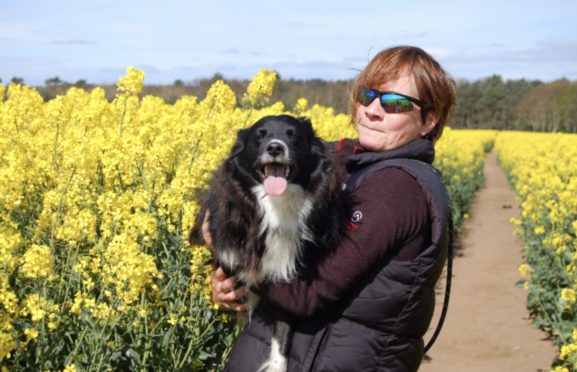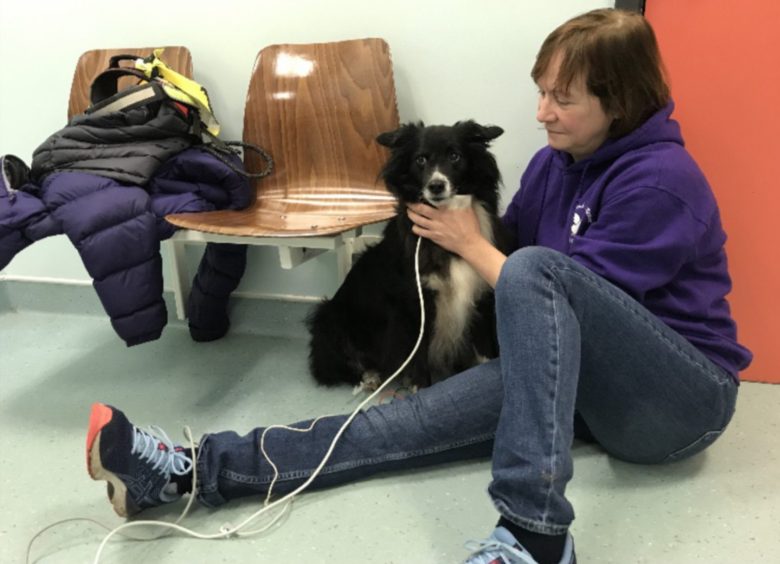
An NHS radiographer has revealed how she gave up her job working in a busy hospital for almost identical work at her local vet school.
Lisa Wright spent 29 years scanning patients at Edinburgh Royal Infirmary until her dog, Buddy, suddenly became ill with serious heart failure.
Vets at The University of Edinburgh’s Royal (Dick) School of Veterinary Studies operated into the early hours of the morning to insert a pacemaker to save the stricken collie’s life – and this inspired her to apply for a job working with animal patients.
And her career swap is one of the incredible ways people and animals are benefiting from shared care and research.
“My dog, Buddy, was the main motivator for moving from human to animal radiography,” she said. “He had become very ill and I realised as I held him before his scan at the vet school that this was a wonderful job.
“He had developed complete heart block and vet cardiologist Geoff Culshaw operated to insert a pacemaker late one Saturday night.
“Jobs in vet radiology are scarce but I had the qualifications and experience as a radiographer and just needed to train to give scans to a whole variety of animals.”
An animal lover
Her work involves scanning snakes, rabbits, dogs, cats, guinea pigs, pet Pacman frogs, bearded dragons, horses and even koala bears and penguins from Edinburgh Zoo.
Her home in East Lothian is a mini animal sanctuary, with 15 horned Soay sheep originally from St Kilda, another rescue collie, a house cat and four feral cats in an outhouse and 19 rescue battery hens.
Wright’s story reflects the pioneering work that crosses the divide between human and animal medicine.
Studies into the early changes in acquired heart disease in people, which kills thousands of Scots every year, can be progressed by the Royal (Dick) School of Veterinary Studies’ examination of early changes in blood vessels in dogs says a leading vet.
It may offer hope to the thousands of people who die every year from heart attacks, strokes, kidney failure and brain changes caused by blood vessels (the vascular system).
Dr Geoff Culshaw, a leading vet cardiologist at The Royal (Dick) School of Veterinary Studies said: “There is much vet and human cardiologists can learn from each other’s research and indeed collaborative work.
“We are currently looking at subtle changes in the function of blood vessels in dogs that may well tell us more about why people develop heart disease, brain degeneration and kidney disease. These vital organs can all be impacted by how blood vessels behave.”
More than 180,000 people in the UK suffer vascular dementia, caused by reduced blood flow to the brain. This is usually due to the narrowing of the small blood vessels deep inside the brain.
Dogs do not live long enough to develop the cardiovascular disease that causes heart attacks, common in people, but very early changes in their blood vessels may well be indicators for later disease in people and allow doctors to prevent them.
Culshaw added: “We can examine how vascular, or blood vessel disease progresses in humans. Essentially, it means looking at these early changes in animals’ blood vessels and seeing how these may pan out or impact people.”
Shared learning
Shared learning or translational findings have been a two-way street for humans and animals, with dogs now being saved by heart pacemakers used in humans to fix very slow heartbeats.
The tiny pacemakers, slightly bigger than a 50p piece, are placed not far under the surface of the skin on the neck, with wires fed down to the heart. Meanwhile, some dogs have benefited from medical research and treatment that uses tiny pieces of scaffolding (stenting) to open blocked arteries in humans.
It is carried out in people at risk of heart attacks and strokes caused by narrowed or blocked blood vessels. Today the same technique is helping to open up narrow heart valves in dogs.
With a similar technique used in humans, the stents are fed through blood vessels and monitored continually through the operation by real-time X-ray equipment and special ultrasound.
“A dog with a blockage to urine leaving its bladder had it opened with a stent recently,” Culshaw said.
He also reveals that vets can study animal pedigrees and the genetics of dogs in order to identify those susceptible to certain diseases, inherited illnesses passed on in family trees.
Pedigree dogs and cats from the same breed are likely to have similar risks for certain diseases.
Analysing and comparing the DNA in affected dogs with unaffected dogs can indicate to researchers which genes might cause or enhance certain diseases.
“We can also move towards identifying the genes that protect dogs against certain illnesses like cardiovascular disease,” Culshaw added.

Enjoy the convenience of having The Sunday Post delivered as a digital ePaper straight to your smartphone, tablet or computer.
Subscribe for only £5.49 a month and enjoy all the benefits of the printed paper as a digital replica.
Subscribe